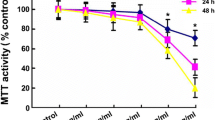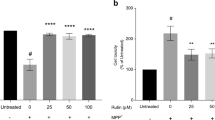Abstract
Advanced glycation end products (AGEs) have been identified in age-related intracellular protein deposits of neurodegenerative diseases. Methylglyoxal (MGO), a dicarbonyl metabolite, is a major precursor of AGEs which have been linked to the development of neurodegenerative diseases. Myricitrin, a flavanoid isolated from the root bark of Myrica cerifera, attenuated 6-OHDA-induced mitochondrial dysfunction and had a potential anti-Parkinson’s disease in our previous investigation. The aims of this study were to investigate the protective effects of myricitrin against MGO-induced injury in SH-SY5Y cells and also to look for the possible mechanisms. The results showed that exposure of SH-SY5Y cells to MGO caused decreases of cell viability, intracellular ATP, mitochondrial redox activity, and mitochondrial membrane potential and an increase in reactive oxygen species generation. However, these mitochondrial dysfunctions were alleviated by co-treatment with myricitrin. Additionally, myricitrin was capable of inhibiting AGEs formation, blocking RAGE expression, and inhibiting NF-κB activation and translocation triggered by MGO in SH-SY5Y cells. Our results suggest that myricitrin alleviates MGO-induced mitochondrial dysfunction, and the possible mechanism is through modulating the AGEs/RAGE/NF-κB pathway. In summary, myricitrin might offer a promising therapeutic strategy to reduce the neurotoxicity of reactive dicarbonyl compounds, providing a potential benefit agent with age-related neurodegenerative diseases.







Similar content being viewed by others
References
Aćimović JM, Jovanović VB, Veselinović MR, Srećković VD, Mandić LM (2011) Method for monitoring of the protein amino group changes during carbonylation. Clin Biochem 44:994–999
Agholme L, Lindström T, Kågedal K, Marcusson J, Hallbeck M (2010) An in vitro model for neuroscience: differentiation of SH-SY5Y cells into cells with morphological and biochemical characteristics of mature neurons. J Alzheimers Dis 20:1069–1082
Antognelli C, Mezzasoma L, Fettucciari K, Talesa VN (2013) A novel mechanism of methylglyoxal cytotoxicity in prostate cancer cells. Int J Biochem Cell Biol 45:836–844
Bakala H, Hamelin M, Mary J, Borot-Laloi C, Friguet B (2012) Catalase, a target of glycation damage in rat liver mitochondria with aging. Biochim Biophys Acta 1822:1527–1534
Bierhaus A, Stern DM, Nawroth PP (2006) RAGE in inflammation: a new therapeutic target? Curr Opin Investig Drugs 7:985–991
Cervantes-Laurean D, Schramm DD, Jacobson EL, Halaweish I, Bruckner GG, Boissonneault GA (2006) Inhibition of advanced glycation end product formation on collagen by rutin and its metabolites. J Nutr Biochem 17:531–540
Dalfó E, Portero-Otín M, Ayala V, Martínez A, Pamplona R, Ferrer I (2005) Evidence of oxidative stress in the neocortex in incidental lewy body disease. J Neuropathol Exp Neurol 64:816–830
Grillo MA, Colombatto S (2008) Advanced glycation end-products (AGEs): involvement in aging and in neurodegenerative diseases. Amino Acids 35:29–36
Harja E, Bu DX, Hudson BI et al (2008) Vascular and inflammatory stresses mediate atherosclerosis via RAGE and its ligands in apoE−/− mice. J Clin Invest 118:183–194
Huang SM, Chuang HC, Wu CH, Yen GC (2008) Cytoprotective effects of phenolic acids on methylglyoxal-induced apoptosis in Neuro-2A cells. Mol Nutr Food Res 52:940–949
Kislinger T, Fu C, Huber B et al (1999) Nε-(carboxymethyl)lysine adducts of proteins are ligands for receptor for advanced glycation end products that activate cell signaling pathways and modulate gene expression. J Biol Chem 274:31740–31749
Kwon SH, Hong SI, Jung YH et al (2012) Lonicera japonica THUNB. protects 6-hydroxydopamine-induced neurotoxicity by inhibiting activation of MAPKs, PI3K/Akt, and NF-κB in SH-SY5Y cells. Food Chem Toxicol 50:797–807
Latruffe N, Elkebbaj MS, Moussard C, Gaudemer Y (1982) Permeability of inner mitochondrial membrane to arginine reagents. FEBS Lett 144:273–278
Li Q, Verma IM (2002) NF-κB regulation in the immune system. Nat Rev Immunol 2:725–734
Li Q, Estepa G, Memet S, Israel A, Verma IM (2000) Complete lack of NFκB activity in IKK1 and IKK2 double-deficient mice: additional defect in neurulation. Genes Dev 14:1729–1733
Magnani E, Bettini E (2000) Resazurin detection of energy metabolism changes in serum-starved PC12 cells and of neuroprotective agent effect. Brain Res Protocol 5:266–272
Mehta R, Shangari N, O'Brien PJ (2008) Preventing cell death induced by carbonyl stress, oxidative stress or mitochondrial toxins with vitamin B anti-AGE agents. Mol Nutr Food Res 52:379–385
Meotti FC, Missau FC, Ferreira J et al (2006a) Anti-allodynic property of flavonoid myricitrin in models of persistent inflammatory and neuropathic pain in mice. Biochem Pharmacol 72:1707–1713
Meotti FC, Luiz AP, Pizzolatti MG, Kassuya CA, Calixto JB, Santos AR (2006b) Analysis of the antinociceptive effect of the flavonoid myricitrin: evidence for a role of the l-arginine-nitric oxide and protein kinase C pathways. J Pharmacol Exp Ther 316:789–796
Moser BR (2008) Efficacy of myricetin as an antioxidant in methyl esters of soybean oil. Eur J Lipid Sci Technol 110:1167–1174
Oya T, Hattori N, Mizuno Y (1999) Methylglyoxal modification of protein. Chemical and immunochemical characterization of methylglyoxal-arginine adducts. J Biol Chem 274:18492–18502
Perez Gutierrez RM (2012) Inhibition of advanced glycation end-product formation by Origanum majorana L. in vitro and in streptozotocin-induced diabetic rats. Evid Based Complement Alternat Med 2012:598638
Phillips SA, Thornalley PJ (1993) The formation of methylglyoxal from triose phosphates. investigation using a specific assay for methylglyoxal. Eur J Biochem 212:101–105
Picklo MJ, Montine TJ, Amarnath V, Neely MD (2002) Carbonyl toxicology and Alzheimer’s disease. Toxicol Appl Pharmacol 184:187–197
Pun PB, Murphy MP (2012) Pathological significance of mitochondrial glycation. Int J Cell Biol 2012:1–13
Qin YH, Dai SM, Tang GS (2009) HMGB1 enhances the proinflammatory activity of lipopolysaccharide by promoting the phosphorylation of MAPK p38 through receptor for advanced glycation end products. J Immunol 183:6244–6250
Rabbani N, Thornalley PJ (2008) Dicarbonyls linked to damage in the powerhouse: glycation of mitochondrial proteins and oxidative stress. Biochem Soc Trans 36:1045–1050
Schmidt AM, Yan SD, Yan SF, Stern DM (2001) The multiligand receptor RAGE as a progression factor amplifying immune and inflammatory responses. J Clin Invest 108:949–955
Shao X, Bai N, He K, Ho CT, Yang CS, Sang S (2008) Apple polyphenols, phloretin and phloridzin: new trapping agents of reactive dicarbonyl species. Chem Res Toxicol 21:2042–2050
Staniszewska MM, Nagaraj RH (2006) Upregulation of glyoxalase I fails to normalize methylglyoxal levels: a possible mechanism for biochemical changes in diabetic mouse lenses. Mol Cell Biochem 288:29–36
Thornalley PJ (1996) Pharmacology of methylglyoxal: formation, modification of proteins and nucleic acids, and enzymatic detoxification: a role in pathogenesis and antiproliferative chemotherapy. Gen Pharmacol 27:565–573
Tian LL, Zhou Z, Zhang Q (2007) Protective effect of (+/−) isoborneol against 6-OHDA-induced apoptosis in SH-SY5Y cells. Cell Physiol Biochem 20:1019–1032
Tirmenstein MA, Hu CX, Scicchitano MS (2005) Effects of 6-hydroxydopamine on mitochondrial function and glutathione status in SH-SY5Y human neuroblastoma cells. Toxicol In Vitro 19:471–479
Voziyan PA, Metz TO, Baynes JW, Hudson BG (2002) A post-Amadori inhibitor pyridoxamine also inhibits chemical modification of proteins by scavenging carbonyl intermediates of carbohydrate and lipid degradation. J Biol Chem 277:3397–3403
Wang YH, Du GH (2009) Ginsenoside Rg1 inhibits beta-secretase activity in vitro and protects against Abeta-induced cytotoxicity in PC12 cells. J Asian Nat Prod Res 11:604–612
Wang SJ, Tong Y, Lu S (2010) Anti-inflammatory activity of myricetin isolated from Myrica rubra Sieb. et Zucc. leaves. Planta Med 76:1492–1496
Wang YH, Xuan ZH, Tian S, He GR, Du GH (2013) Myricitrin attenuates 6-hydroxydopamine-induced mitochondrial damage and apoptosis in PC12 cells via inhibition of mitochondrial oxidation. J Funct Foods 5:337–345
Webster J, Takahashi Y, Suzuki E (2005) The carbonyl scavengers aminoguanidine and tenilsetam protect against the neurotoxic effects of methylglyoxal. Neurotox Res 7:95–101
Wu CH, Yen GC (2005) Inhibitory effect of naturally occurring flavonoids on the formation of advanced glycation endproducts. J Agric Food Chem 53:3167–3173
Wu CH, Yeh CT, Shih PH, Yen GC (2010) Dietary phenolic acids attenuate multiple stages of protein glycation and high-glucose-stimulated proinflammatory IL-1beta activation by interfering with chromatin remodeling and transcription in monocytes. Mol Nutr Food Res 54:S127–S140
Xie HR, Hu LS, Li GY (2010) SH-SY5Y human neuroblastoma cell line: in vitro cell model of dopaminergic neurons in Parkinson’s disease. Chin Med J 123:1086–1092
Yan SD, Chen X, Fu J et al (1996) RAGE and amyloid-beta peptide neurotoxicity in Alzheimer’s disease. Nature 382:685–691
Zhang Y, Jiang L, Hu W, Zheng Q, Xiang W (2011) Mitochondrial dysfunction during in vitro hepatocyte steatosis is reversed by omega-3 fatty acid-induced up-regulation of mitofusin 2. Metabolism 60:767–775
Acknowledgments
This research was supported by grants from the National Natural Science Foundation of China (30973889), Science and Technology Major Projects: significant new-drugs creation (2012ZX09103101-078; 2012ZX09103201-042; 2011ZX09401-014), and the Research Special Fund for Public Welfare Industry of Health (200902008).
Author information
Authors and Affiliations
Corresponding authors
Rights and permissions
About this article
Cite this article
Wang, YH., Yu, HT., Pu, XP. et al. Myricitrin Alleviates Methylglyoxal-Induced Mitochondrial Dysfunction and AGEs/RAGE/NF-κB Pathway Activation in SH-SY5Y Cells. J Mol Neurosci 53, 562–570 (2014). https://doi.org/10.1007/s12031-013-0222-2
Received:
Accepted:
Published:
Issue Date:
DOI: https://doi.org/10.1007/s12031-013-0222-2




